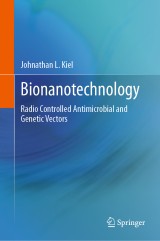Details

Bionanotechnology
Radio Controlled Antimicrobial and Genetic Vectors|
139,09 € |
|
| Verlag: | Springer |
| Format: | |
| Veröffentl.: | 24.07.2024 |
| ISBN/EAN: | 9783031630064 |
| Sprache: | englisch |
Dieses eBook enthält ein Wasserzeichen.
Beschreibungen
<p>This book describes how methodologies in biochemistry, molecular and cellular biology, electromagnetic bioeffects, and nanotechnology were brought together to construct a nanostructure that is a composite of nucleic acid, carbon nanotube, paramagnetic metallic nanoparticles, and aromatic polymer that is responsive to nonionizing electromagnetic radiation, RFR to microwaves. It demonstrates that the construct can act as a redox catalyst accelerated by nonionizing electromagnetic radiation, and also as a conveyor of genetic modification of specifically targeted eukaryotic and prokaryotic cells. The scientific knowledge necessary to accomplish this is described and step-by-step progress supported by data and examples are noted. The general purpose is to show how such interdisciplinary approaches can lead to disruptive technologies.</p>
This book is most valuable to those (molecular biologists, vaccinologists, biomedical engineers, microbiologists) looking for more externally controllable gene vectors, antimicrobials, and antiparasitics, using a totally new nanoparticle platform. Those pursuing biological applications of nanotechnology will also be interested. This text has uniquely multidisciplinary approaches, drawing together chemistry, physics, molecular biology, biochemistry, and biomedical and electrical engineering.<p></p>
This book is most valuable to those (molecular biologists, vaccinologists, biomedical engineers, microbiologists) looking for more externally controllable gene vectors, antimicrobials, and antiparasitics, using a totally new nanoparticle platform. Those pursuing biological applications of nanotechnology will also be interested. This text has uniquely multidisciplinary approaches, drawing together chemistry, physics, molecular biology, biochemistry, and biomedical and electrical engineering.<p></p>
<p>Preface.- Introduction.- Foundation Principles and Dosimetry of Radiofrequency Radiation.- Theory and Measurement: Relaxation vs Resonance.- Phenomenology of RFR Absorption by Biological Molecules and Membranes.- Splitting Hairs: Fine and Hyperfine Splitting and Free Radicals.- Required Characteristics of a Nanostructure Radiofrequency and Microwave Absorbing Vector.- Seeking Explanations for Paradoxical Responses: Bringing It All Together.- Nonionizing Electromagnetic Radiation Driven Microbiological Effects.- Effects on Eukaryotic Cells of Biosynthesis of Radiofrequency and Microwave Radiation Absorbing Polymer.- Moving toward a Totally Synthetic Autonomous Nanoparticle.- Future Applications Beyond Microbial Killing: Promise or Peril?.- Index.</p>
Dr. Johnathan Kiel served 35 years of combined active duty military (13 years) and civilian service (22 years) in the Air Force, until May 2011. He retired at the level of Senior Scientist in the Senior Executive Service, a civilian equivalent of a Brigadier General, in the combined fields of electromagnetic bioeffects and counterproliferation of chemical and biological weapons. During his tenure at the Air Force Research Laboratory and School of Aerospace Medicine, he taught physicians, nurses, medical and entomological technicians about snake venom toxicology, field and medical treatments of the associated injuries, and infectious disease such as anthrax as part of Force Health Protection continuing education (approved as medical and nursing CE for licensure). He also led a research team in basic research on non-ionizing radiation bioeffects, and in basic and applied research in biosurveillance and counterproliferation of Select Biological Agents (Especially Dangerous Pathogens) and other high-impact zoonotic diseases.
<p>This book describes how methodologies in biochemistry, molecular and cellular biology, electromagnetic bioeffects, and nanotechnology were brought together to construct a nanostructure that is a composite of nucleic acid, carbon nanotube, paramagnetic metallic nanoparticles, and aromatic polymer that is responsive to nonionizing electromagnetic radiation, RFR to microwaves. It demonstrates that the construct can act as a redox catalyst accelerated by nonionizing electromagnetic radiation, and also as a conveyor of genetic modification of specifically targeted eukaryotic and prokaryotic cells. The scientific knowledge necessary to accomplish this is described and step-by-step progress supported by data and examples are noted. The general purpose is to show how such interdisciplinary approaches can lead to disruptive technologies.</p>This book is most valuable to those (molecular biologists, vaccinologists, biomedical engineers, microbiologists) looking for more externally controllable gene vectors, antimicrobials, and antiparasitics, using a totally new nanoparticle platform. Those pursuing biological applications of nanotechnology will also be interested. This text has uniquely multidisciplinary approaches, drawing together chemistry, physics, molecular biology, biochemistry, and biomedical and electrical engineering.<p></p>
Points out how the technology might be misused and addresses potential biosafety and biosecurity issues Describes self-replicating functional nucleic acids encased in a non-protein (low or no immunogenicity) carrier Provides sufficient detail and supporting materials to empower scientists and engineers to effect new applications
Diese Produkte könnten Sie auch interessieren:

Neutron Applications in Earth, Energy and Environmental Sciences

von: Liyuan Liang, Romano Rinaldi, Helmut Schober

149,79 €

Nanobioelectronics - for Electronics, Biology, and Medicine

von: Andreas Offenhäusser, Ross Rinaldi

96,29 €














